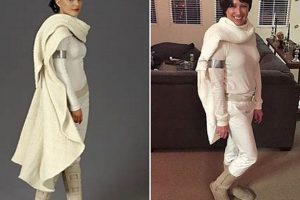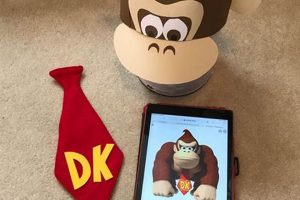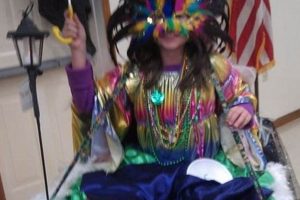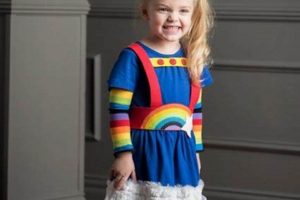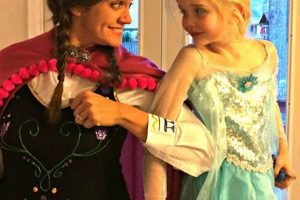The phrase identifies a specific type of homemade Halloween or cosplay outfit. It refers to the creation of a chilling or unsettling semblance of a child’s plaything through the use of clothing, makeup, and accessories. As an example, individuals might employ tattered dresses, exaggerated makeup replicating porcelain features, and strategically placed cracks or smudges to achieve the desired frightening aesthetic.
The significance of creating such an outfit lies in its ability to evoke a primal sense of unease and tap into cultural anxieties surrounding innocence corrupted. The effectiveness of this costume style stems from its subversion of the familiar, transforming a comforting childhood object into something sinister. Historically, the allure of similar disguises has been consistent, appearing in various forms across folklore, literature, and film, capitalizing on the uncanny valley effect.
Subsequent sections will explore the key elements involved in successfully executing such a project, encompassing makeup techniques, garment alteration and sourcing, and accessory selection, to enable the construction of a convincingly frightening appearance.
“Creepy Doll Costume DIY” – Crucial Tips
Achieving a truly unsettling doll-like appearance requires attention to detail and a strategic approach. The following provides guidance on maximizing the impact of such a creation.
Tip 1: Makeup Foundations: Establish a base of unnaturally pale skin. Employ white face paint or foundation several shades lighter than the natural skin tone. Ensure even application and consider setting with powder to prevent creasing.
Tip 2: Exaggerated Features: Amplify the doll-like features through makeup. Enlarge the eyes with white eyeliner on the lower waterline and draw oversized pupils using black eyeliner. Extend the lashes dramatically with mascara or false eyelashes.
Tip 3: Porcelain Cracks: Introduce an element of decay through carefully placed cracks. Use a fine-tipped eyeliner brush and black or dark brown eyeliner to draw thin, irregular lines originating from the corners of the eyes and mouth. Blend slightly for a more realistic effect.
Tip 4: Vintage Garments: Select clothing reminiscent of antique dolls. Opt for dresses or pinafores with lace, ruffles, or floral patterns. Distressed or aged fabrics contribute to the overall unsettling aesthetic.
Tip 5: Strategic Distressing: Enhance the unsettling nature of the clothing. Apply rips, tears, and stains strategically. Consider using tea or coffee to stain the fabric for an aged appearance.
Tip 6: Unnatural Posture: Adopt stiff, jerky movements to mimic the limited articulation of a doll. Practice maintaining a rigid posture and tilting the head at unnatural angles.
Tip 7: Accessorize Judiciously: Incorporate accessories that enhance the unsettling nature of the costume. Consider carrying a tattered doll, wearing old-fashioned shoes, or adding a vintage-style hair ribbon.
By diligently applying these recommendations, the wearer can maximize the unsettling impact of a homemade costume, effectively transforming into a truly memorable and frightening character.
The following will focus on sources of inspiration, exploring examples from popular culture and artistic representations.
1. Makeup Techniques
Makeup techniques constitute a foundational element in the successful execution of a “creepy doll costume diy.” The artistry applied to the face transforms the wearer into an unsettling simulacrum of a childhood toy, playing on themes of the uncanny and distorted innocence.
- Porcelain Skin Simulation
Achieving a flawless, unnaturally pale complexion is crucial. This necessitates employing a high-coverage foundation several shades lighter than the wearer’s natural skin tone. Setting the base with translucent powder minimizes shine and creates a matte, porcelain-like finish. In professional stage productions, artists often use airbrush techniques to achieve an even and seamless application, which can be adapted for more sophisticated at-home creations.
- Exaggerated Eye Morphology
Enlarging the eyes beyond natural proportions enhances the doll-like appearance. White eyeliner applied to the lower waterline creates the illusion of larger eyes, while carefully drawn black eyeliner can outline an enlarged iris. Adding dramatic false eyelashes, both above and below the eye, further accentuates this effect. A real-world example includes replicating the exaggerated eye makeup styles seen in certain forms of Japanese doll-inspired fashion, known as “Living Dolls.”
- Fractured Appearance Replication
Introducing elements of damage or decay elevates the unsettling nature of the costume. This is typically achieved by carefully drawing hairline cracks with a fine-tipped eyeliner brush, originating from the corners of the eyes and mouth. These lines should be subtly blended to appear as fractures in porcelain, rather than harsh lines. In special effects makeup for film, similar techniques are used to create realistic skin damage, demonstrating the technique’s versatility.
- Unnatural Lip Definition
Modifying the natural lip shape contributes to the overall artificiality of the look. Often, this involves drawing a smaller, more rounded lip shape using lip liner and filling it in with a dark or muted color. Alternatively, the lips can be completely obscured with foundation and a new, doll-like mouth painted above or below the natural lip line. An example of this can be seen in interpretations of classic clown makeup, where the mouth is intentionally distorted for visual effect.
These techniques, when applied with precision and attention to detail, are indispensable for transforming a person into a convincingly unsettling doll-like figure. The makeup alone can create a powerful visual impact, and, in conjunction with appropriate garment selection and distressing, serves to amplify the overall effect.
2. Garment Selection
Garment selection is pivotal in achieving a convincingly unsettling result. The attire worn significantly contributes to the overall aesthetic, functioning as a visual indicator of the doll’s age, history, and level of decay, thus contributing to the desired unsettling impression.
- Vintage Aesthetic:
The garments should evoke a sense of history, often referencing styles from earlier decades. Dresses, pinafores, and blouses with lace, ruffles, or floral patterns are commonly employed. The intention is to suggest a bygone era, subtly implying the doll’s existence extends beyond a typical lifespan. Examples might include Victorian-era dresses or early 20th-century schoolgirl uniforms, readily available in vintage stores or online marketplaces. This choice imparts a sense of faded innocence, contrasted
with the intended disturbing effect. - Fabric Texture and Color Palette:
The texture and color of the chosen fabric profoundly influence the impression created. Opting for faded, muted colors, such as creams, pale pinks, or washed-out blues, reinforces the vintage aesthetic. Textures like aged lace or worn cotton contribute to the impression of a well-loved, yet deteriorating object. Deliberately avoiding modern synthetic fabrics is crucial, as their appearance undermines the desired sense of age and history. This consideration parallels the attention to detail employed in period costume design for film and theater.
- Strategic Distressing:
Introducing damage and decay to the garments is essential. This can involve techniques such as ripping, tearing, staining, and fraying. Strategic placement of these imperfections, such as around the hemline or at stress points, enhances the realism of the effect. Tea staining or coffee staining can impart an aged appearance to the fabric. In professional costuming, similar techniques are used to depict the effects of time and wear on clothing, providing a reference for effective distressing.
- Silhouette and Fit:
The garment’s silhouette contributes to the unnerving nature of the persona. Ill-fitting clothing, either too large or too small, can create a sense of unease and mimic the disproportions often associated with dolls. The overall shape of the garment should also complement the character’s intended portrayal, whether innocent and childlike or more sinister and imposing. The selection of a silhouette that clashes with the wearer’s natural physique enhances the unnerving effect, creating a distortion of familiar forms.
In essence, the careful choice and manipulation of garments play a crucial role in solidifying the doll-like appearance. By paying meticulous attention to vintage aesthetics, fabric properties, strategic distressing, and silhouette, the wearer can amplify the unsettling impact of the costume, effectively transforming themselves into a chilling representation of a corrupted childhood icon.
3. Distressing methods
Distressing methods are intrinsically linked to the creation of an effective doll costume. The artificial appearance of a doll, when coupled with signs of age and damage, amplifies the unsettling effect. Techniques to simulate wear and tear are thus crucial for conveying a sense of decay, neglect, or even malicious mistreatment, transforming a benign childhood object into a source of fear. For instance, a pristine, untouched dress lacks the narrative depth achieved by one bearing simulated stains and tears. A real-life example of this is seen in horror films where dolls often exhibit visible damage, suggesting a history of disturbing events. The success of a doll costume hinges on convincingly portraying this simulated history through appropriate distressing techniques.
The application of these methods requires careful consideration of cause and effect. Tears should appear naturally, as though resulting from stress or snagging. Stains should be strategically placed to suggest spills or prolonged exposure to the elements. Fraying along edges contributes to the impression of prolonged use. Specific techniques might include using sandpaper to abrade fabric, carefully creating small tears with a seam ripper, or applying diluted tea or coffee to create realistic stains. The effectiveness of these techniques can be observed in museum displays of antique clothing, where careful observation reveals the authentic patterns of wear and tear resulting from actual use and age.
In conclusion, distressing methods are not merely cosmetic additions; they are fundamental to establishing the desired narrative and visual impact of a doll costume. Skillful application of these techniques transforms a simple outfit into a potent symbol of corrupted innocence and unsettling artifice. The challenge lies in balancing the artificiality of the doll form with the realism of simulated damage, ensuring a cohesive and believable portrayal. This nuanced understanding of distressing methods elevates a costume from a simple imitation to a sophisticated representation of a chilling concept.
4. Hairstyle accuracy
Hairstyle accuracy forms an integral component in the creation of a visually convincing costume. Within the specific context of imitating a doll, meticulous attention to hairstyle contributes significantly to the illusion, reinforcing the artificial and potentially unsettling nature of the character.
- Replicating Common Doll Hairstyles
Certain hairstyles are frequently associated with dolls, such as braids, pigtails, and ringlets. Accurately replicating these styles is essential for establishing the doll-like appearance. The specific hairstyle chosen should align with the overall aesthetic of the costume, be it Victorian, antique, or contemporary doll. For instance, tightly wound ringlets are often associated with antique porcelain dolls, while neatly braided pigtails are characteristic of younger, more modern dolls. Failure to accurately replicate these stereotypical hairstyles undermines the illusion, diminishing the costume’s overall impact.
- Maintaining Artificiality and Rigidity
Dolls’ hair often lacks the natural movement and fluidity of human hair. Therefore, achieving a degree of stiffness or unnaturalness in the hairstyle is crucial. This can be accomplished through the use of hairspray, gel, or other styling products to maintain the desired shape and prevent excessive movement. Some costume designers even incorporate wire or other supportive structures to ensure the hairstyle retains its form throughout wear. The goal is to replicate the sculpted or molded appearance typical of doll hair, contributing to the overall artificiality of the character.
- Incorporating Color and Texture
Doll hair frequently exhibits unnatural colors or textures. Brightly colored wigs or hair extensions can be used to replicate this effect, adding to the unsettling nature of the costume. Textural elements, such as crimping or teasing, can also contribute to the doll-like appearance. For example, a bright red wig styled into tight crimps might evoke the image of a vintage Raggedy Ann doll, while a platinum blonde wig with severe, angular cuts could suggest a more modern, dystopian doll character. The selection of color and texture should align with the overall theme of the costume, enhancing its visual impact and unsettling qualities.
- Adding Damage or Decay to the Hair
As with other aspects of the costume, incorporating elements of damage or decay into the hairstyle can enhance the overall unsettling effect. This might involve tangling the hair, adding dirt or debris, or even partially removing sections to simulate hair loss. These details suggest a history of neglect or mistreatment, contributing to the disturbing narrative implied by the costume. The addition of cobwebs, twigs, or other foreign objects to the hair can further amplify this effect, creating a visually arresting and unsettling image. For instance, tangled and matted hair adorned with artificial cobwebs suggests a doll that has been abandoned and forgotten, adding depth and complexity to the costume’s portrayal.
By carefully considering hairstyle accuracy, and implementing strategies to repli
cate typical doll hairstyles, maintain artificiality, incorporate unique colors and textures, and simulate damage or decay, the effectiveness of a “creepy doll costume diy” can be significantly enhanced. The hairstyle serves as a crucial visual cue, reinforcing the artificial and potentially unsettling nature of the character, and contributing to the overall success of the costume.
5. Posture enactment
Posture enactment is a critical element in achieving a convincing representation. It transcends mere physical positioning; it embodies the inherent limitations and unnaturalness associated with dolls, thereby amplifying the intended unsettling effect. The success of any costume hinges on the wearer’s ability to physically embody the characteristics of the intended persona, and this holds particularly true when attempting to replicate a doll.
- Stiffness and Limited Articulation
Dolls, unlike humans, possess limited ranges of motion and exhibit a certain stiffness in their joints. Emulating this requires conscious effort to restrict natural fluidity of movement. Actions should be deliberate and somewhat jerky, avoiding smooth transitions. Real-world examples of this technique can be observed in stage performances where actors portray inanimate objects, such as automatons or robots, effectively conveying a lack of natural grace. The implications for the doll are significant, as this restraint contributes to the unnatural and potentially unsettling nature of the character.
- Head Tilting and Fixed Gaze
Dolls often exhibit a characteristic head tilt and a fixed, unwavering gaze. Replicating this requires maintaining a consistent angle of the head, often slightly to one side, and focusing the eyes on a distant point without blinking excessively. This creates a sense of detachment and artificiality, contributing to the overall unsettling impression. Studies in nonverbal communication indicate that prolonged eye contact without blinking can elicit discomfort in observers, making this a particularly effective technique for enhancing the “creepy” aspect of the costume.
- Unnatural Limb Positioning
Dolls’ limbs are often positioned in ways that appear unnatural or uncomfortable for humans. For example, arms might be held rigidly at the sides, or legs might be slightly turned inward. Replicating these poses requires consciously overriding natural postural tendencies. In the field of physical therapy, techniques are used to correct postural imbalances; understanding these principles can aid in creating convincingly unnatural limb positions. The implications for the costume are that these distorted postures contribute to the sense of the uncanny valley, making the wearer appear both familiar and disturbingly different.
- Maintaining Character Consistency
The chosen posture must remain consistent throughout the portrayal. Any deviation from the established physical mannerisms will undermine the illusion. Therefore, meticulous planning and practice are essential. Actors often spend considerable time developing and refining a character’s physicality, and a similar level of dedication is required to effectively embody the posture of a doll. The implications are that consistent and unwavering posture reinforces the artificiality of the doll, enhancing the unnerving quality of the portrayal.
In summary, posture enactment transcends mere physical positioning; it embodies the limitations and unnaturalness associated with dolls. This element, when executed effectively, significantly amplifies the unsettling impact, transforming a simple costume into a convincingly disturbing portrayal.
Frequently Asked Questions
This section addresses common inquiries regarding the construction and execution of a successful project, providing guidance on technical aspects and aesthetic considerations.
Question 1: What is the most effective method for creating a convincingly pale complexion?
Achieving an unnaturally pale complexion requires the application of a high-coverage foundation several shades lighter than the individual’s natural skin tone. Setting this base with a translucent powder minimizes shine and creates a matte, porcelain-like finish. Application with a makeup sponge or airbrush offers a more uniform result.
Question 2: How can garment distressing techniques be employed without compromising the structural integrity of the fabric?
Strategic distressing should focus on creating the illusion of wear and tear without causing significant damage. Employing techniques such as light sanding, careful tearing with a seam ripper, and controlled staining with diluted tea or coffee offers the desired effect while preserving the garment’s overall shape and function.
Question 3: What is the recommended approach for exaggerating eye size and creating a doll-like gaze?
Exaggerating eye size involves using white eyeliner on the lower waterline to create the illusion of larger eyes, coupled with the application of voluminous false eyelashes. A fixed, unwavering gaze, achieved by focusing on a distant point and minimizing blinking, contributes to the doll-like effect.
Question 4: What are the most suitable fabric choices for replicating a vintage doll aesthetic?
Fabrics such as aged lace, worn cotton, and muted floral prints are effective for replicating a vintage doll aesthetic. Avoiding modern synthetic fabrics, which lack the desired sense of age and history, is crucial. Opting for heavier materials can also lend a more structured, doll-like form.
Question 5: How can the application of facial “cracks” be achieved with realistic results?
Realistic facial cracks are achieved through the use of a fine-tipped eyeliner brush and a dark brown or black eyeliner. Thin, irregular lines should be drawn originating from the corners of the eyes and mouth, and subtly blended to simulate fractures in porcelain, rather than appearing as harsh, artificial lines.
Question 6: What is the optimal method for achieving a stiff, unnatural posture reminiscent of a doll?
Achieving a stiff, unnatural posture requires conscious effort to restrict natural fluidity of movement. Maintaining a consistent head tilt, fixing the gaze, and consciously limiting limb articulation are crucial elements. Practice and self-awareness are essential for maintaining this posture consistently throughout wear.
The information presented aims to address specific technical challenges and aesthetic considerations crucial for the successful execution of a costume. Careful attention to these details enhances the overall impact.
Subsequent discussions will delve into the ethical considerations and potential sensitivities surrounding the portrayal of such a character.
Conclusion
The preceding sections have comprehensively explored the creation of such a specific look. Elements spanning makeup application techniques, garment selection and modification, accessory implementation, and postural enactment were analyzed to provide actionable guidance. Each component significantly contributes to the overall success of the transformation, emphasizing the importance of meticulous execution and cohesive integration of individual elements.
Careful consideration and deliberate effort are paramount in constructing a convincing and potentially unsettling portrayal. A complete understanding of the techniques described is essential for those undertaking this endeavor, ensuring a nuanced and impa
ctful representation.


